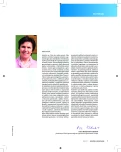Determination of subjective changes in swallowing of elderly patients
Authors:
L. Karásková; J. Škvrňáková; P. Mandysová
Authors‘ workplace:
Fakulta zdravotnických studií, Univerzita Pardubice
Published in:
Geriatrie a Gerontologie 2012, 1, č. 1: 20-23
Category:
Original Article/Study
Overview
Determination of subjective changes in swallowing of elderly patients Swallowing disorders (aphagopraxia) are fairly common problem which causes a lot of serious, life-threatening complications. Their formation involves a wide range of causes e.g. tumorous, inflammatory, cardiovascular and neurological diseases or head and neck injuries. A considerable incidence of swallowing disorders is also associated with the old age. International studies and scientific literature show various values depending on the population and the type of study where the percentage of the incidence of swallowing disorders of persons over 65 years range from 13,8 % to 50 %. Physiological changes in the digestive tract happen in connection with degenerative, morphologic and functional changes of elderly patients’ organs. They may result in possible problems with swallowing. That is why we are focused on persons over sixty-five years in our research study to confirm or disproved this theory. The running preliminary results of our investigations have revealed the occurrence of swallowing disorders in persons over 65 years in 55,36 %. To collect the data we used the subjective evaluation of swallowing function method and EAT-10 questionnaire. This thesis presents the running preliminary results of our investigations which still continue.
Key words:
dysphagia – EAT-10 –Mini-Cog – seniors – quality of life
Sources
1. Kawashima, K., Motohashi, Y., Fujishima, I.: Prevalence of dysphagia among community-dwelling elderly individuals as estimated using a questionnaire for dysphagia screening. Dysphagia 2004; 19(4): 266–271.
2. Roy, N., Stemple, J., Merrill, R. M. et al.: Dysphagia in the elderly: Preliminary evidence of prevalence, risk factors, and socioemotional effect. Annals of Otology, Rhinology And Laryngology 2007; 116(11): 858–865.
3. Allepaerts, S., Delcourt, S., Wislez, S. et al.: Promoting factors of laryngeal penetrations in elderly. Gériatrie et psychologie neuropsychiatrie du vieillissement 2011; 9(1): 45–50.
4. Tedla, M., Komínek, P., Chrobok, V. a kol.: Poruchy polykání. 1. vyd. Havlíčkův Brod: Tobiáš 2009.
5. Jurašková, B. Hrnčiariková, D., Holmerová, I. a kol.: Poruchy výživy ve stáří. Medicína pro praxi (online) 2007; 4(11): 443–446, (cit. 2011–07-09). Dostupný z: www.solen.cz/pdfs/med/2007/11/02.pdf
6. Chen, P. H., Golub, J. S., Hapner, E. R. et al.: Prevalence of perceived dysphagia and quality-of-life impairment in a geriatric population. Dysphagia 2009; 24(1): 1-6.
7. Škodová, E., Jedlička, I. a kol.: Klinická logopedie. 2. aktualiz. vyd. Praha: Portál 2007.
8. Gasiorowska, A., Fass, R.: Current Approach to Dysphagia. Gastroenterology & Hepatology (online) 2009; 5(4): 269–279, (cit. 2011-07-03). Dostupný z: www.clinicaladvances.com/article_pdfs/gh-article-200904-fass.pdf
9. Nečas, E.: Patologická fyziologie orgánových systémů: Část 2. 1. vyd. Praha: Karolinum 2007.
10. Benešová, P., Mikulajová, P., Mandysová, P. a kol.: Polykací funkce u seniorů. Sestra 2011; 10(21): 62–64.
11. Borson, S., Scanlan, J. M., Watanabe, J. et al.: Improving identification of cognitive impairment in primary care. International Journal of Geriatric Psychiatry 2006; 21(4): 349–355.
12. Belafsky, P. C., Mouadeb, D. A., Rees, C. J. et al.: Validity and reliability of the eating assessment tool (EAT-10). Annals of Otology, Rhinology and Laryngology 2008; 117(12): 919–924.
13. Mandysová, P., Petržílková, K., Škvrňáková, J., Karásková, L.: Subjektivně pociťované potíže s polykáním – využití nástroje EAT-10. In: Česká a Slovenská neurologie a neurochirurgie 2011; 74(107): 118–119.
14. Mandysová, P., Zeleníková, R.: Ošetřovatelská péče o nemocné s poruchami polykání. In: Tedla, M., Komínek, P. (eds). Poruchy polykání. Havlíčkův Brod: Tobiáš 2009: 218–235.
Labels
Geriatrics General practitioner for adults Orthopaedic prostheticsArticle was published in
Geriatrics and Gerontology

2012 Issue 1
Most read in this issue
- Legal liability for damage, caused to patient in health care facility, according to civil law
- Psychiatric assessment in older age
- Social relationships in old age
- Determination of subjective changes in swallowing of elderly patients
